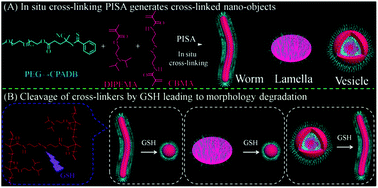In situ cross-linking polymerization-induced self-assembly not only generates cross-linked structures but also promotes morphology transition by the cross-linker†
Abstract
In comparison with the post-polymerization cross-linking strategy, in situ cross-linking by divinyl comonomers in polymerization-induced self-assembly (PISA) is a more straightforward and convenient approach to produce structurally stabilized nano-objects. However, cross-linking usually lowers the chain mobility and hence prevents morphology transition, so formation of higher order morphologies (worm-like micelles or vesicles) by the in situ cross-linking strategy in PISA has always been a great challenge. In this work, not only cross-linked structures but also a promoting effect on morphology transition has been observed during the in situ cross-linking PISA. Worm-like micelles, lamella and vesicles with stabilized (cross-linked) structures are produced by RAFT dispersion copolymerization of 2-(diisopropylamino)ethyl methacrylate (DIPEMA) and the divinyl comonomer cystaminebismethacrylamide (CBMA). The morphology transition is not prevented due to the slower consumption of CBMA than that of the DIPEMA, and the cross-linking process is mostly delayed to the late stage of polymerization. What is surprising, compared with RAFT dispersion polymerization of DIPEMA in the absence of CBMA, is that polymeric nano-objects with higher order morphologies are generated in most cases of the RAFT dispersion copolymerization of DIPEMA and CBMA. The slower consumption of CBMA generates branched structures of the solvophobic blocks, which significantly promote the morphology transition. Cleavage of the cross-linkers (disulfide linkage) by incubating with glutathione (GSH) leads to the morphology transition of the nano-objects to the lower order ones, which further demonstrates the promoting effect on morphology transition in in situ cross-linking PISA.

- This article is part of the themed collection: Polymer Chemistry Most Popular 2021


 Please wait while we load your content...
Please wait while we load your content...